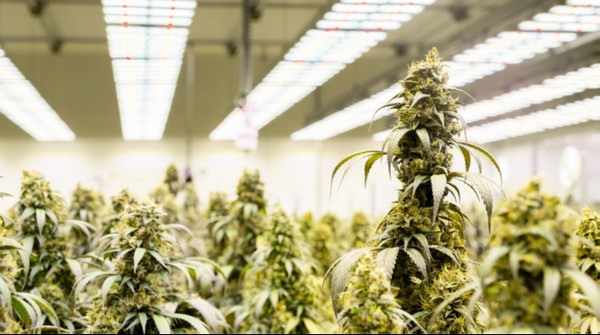One of the primary challenges in the cultivation of cannabis is the standardization and consistency of the final product from batch to batch. Understanding how management practices impact the final product can aid in creating management protocols that increase the product’s quality, productivity, and stability. In this article, Delphy would like to delve a little deeper into what is known and not known about the influence of crop management practices on the flower yield and production of cannabinoids.
Pruning
In terms of crop management practices, there are various techniques that can be applied by growers to increase the yield of flower biomass and the production of chemical compounds. A commonly used management practice in cannabis cultivation is cover pruning by removing the apical meristem just above the top node, also known as “topping.” This changes the plant’s hormone balance by reducing the production of auxin, which stimulates the growth of side branches creating an even canopy and resulting in more equal light capture by the plant. This technique is commonly performed on rooted cuttings on the day of transplanting to bigger pots or during the transition to a short-day lighting schedule.
Another commonly used practice is changing the plants’ architecture by removing a third of the bottom branches and leaves several weeks before harvest. This increases light penetration and reduces micro-climate gradients. By increasing light penetration to the shoot, the development of the plant can be affected in several ways. Higher light intensity at the base of the plant means there is a warmer and drier micro-climate. With increased light exposure and a warmer temperature, the photosynthesis rate is stimulated, accelerating growth.
By applying the mentioned techniques, it is possible to increase flower yield, as well as increase the production of cannabinoids and create more uniformity in cannabinoid distribution across the plant. However, the effect of the pruning technique applied can vary for each cultivar. When choosing a pruning strategy, the labor costs and the end goal should be taken into account, whether it’s to improve yield, alter the microclimate, or encourage more uniform cannabinoid production in the plant.
Water stress
Another crop management practice to improve cannabinoid production could be to give the plant water stress through irrigation. Water availability is extremely important to ensure the plant develops and grows properly and for many other crops, it is well known that low to medium water stress can increase secondary metabolite production. In a recent study, where cannabis plants were subjected to water stress in the 7th week of flowering, increases in cannabinoids such as THC, CBD, THCA, and CBDA were found without influencing the overall flower yield. This highlights the potential for the use of water stress to stimulate the production of certain cannabinoids.
However, and this should go without saying, the response to this type of stress can be different depending on the cultivar and the level, frequency, and timing of water stress. If the plant experiences too much water stress, stomata will close to prevent water loss. This will influence leaf gas exchange, and consequently, the CO2 assimilation rate will decrease, and other metabolic processes will be reduced. It is important to note that the growing environment, the substrate being used, the size of the cultivation container, and the cultivar – since some are more tolerant than others – all affect the irrigation requirements. To find the right irrigation strategy, future research that evaluates different levels of water availability for various cannabis cultivars will help figure out the influence of water stress on flower yield and cannabinoid production.
Delphy’s cannabis research
It is important to realize that there are still some uncertainties about the effect of crop management practices on flower yield and cannabinoid production. There are always various factors at play in determining the plants’ overall growth and development. Each crop management practice not only influences the plant directly but also its surrounding environment, which can be of great influence on overall cannabis production. The influence of environmental factors will be explained more in an upcoming article. For now, the necessity of applied research in cannabis cultivation is very clear. "At Delphy, we are currently developing a state-of-the-art research facility specifically dedicated to cannabis cultivation research. Delphy’s Team Cannabis, together with several partners from the industry, plans to conduct applied research focusing on crop management practices, lighting strategies, climate, fertilization, crop protection, etc., with the end goal of improving the yield, quality, and stability of cannabis flowers and chemical compounds."
Furthermore, Delphy will be giving a 2-week training: Cannabis Cultivation Expert Training (19th till 30th of September 2022) together with Arno Hazekamp. The training offers a great deal of information given by experts from the field and is specifically designed for cannabis growers or plant growers who wish to switch to cannabis cultivation.
For more information:
Delphy 
https://delphy.nl/wp-content/uploads/2022/07/Cannabis-Cultivation-Expert-Programma.pdf
https://delphy.nl/en/teams/team-cannabis/
+31 (0)10 522 1771
[email protected]
Sign up for our daily Newsletter and stay up to date with all the latest news!
Subscribe I am already a subscriber